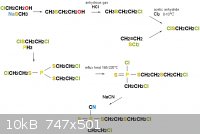AndersHoveland
Hazard to Other Members, due to repeated speculation and posting of untested highly dangerous procedures!
    
Posts: 1986
Registered: 2-3-2011
Member Is Offline
Mood: No Mood
|
|
highly toxic acetylcholinesterase-inhibitor
found this on a russian site, supposedly several times more potent than VX. The product is described as a yellow-tinged viscous oily liquid.
This should really not be so surprising because the molecule also has structural elements of sulfur-alkylating agents and a cyanide group that can
hydrolyse off.
Not really concerned about safety of posting this information, because the actual synthesis would be more complex. If one just tried to mix these
chemicals together without knowing the details, it is doubtful that the product could even be formed. But these types of synthesis routes are
interesting from a purely academic perspective (would never want to try anything remotely similar to this!!)
one could suppose the high toxicity is likely due to the absence of oxygen atoms, meaning no hydrogen bonding, making the molecule hydrophobic. not
sure how those alkylating groups affect the toxicity, this molecule would be very toxic on its own even without the acetylcholinesterase
enzyme-inhibition effects. Of course, the cyanide group will eventually hydrolyse off to HCN, but this effect would be insignificant compared to the
other mechanisms of toxicity
Apparently there are two routes to prepare the 2-chloroethyl- sulfenyl chloride, ClSCH2CH2Cl, a laboratory procedure and the industrial route.
The thermal disproportionation reaction of the posphorous tri( chloroethylthionate) is also interesting. There must be a method to make posphorous
tri(chloroethylthionate) from phosphorous trichloride, but not sure what this would be.
I think it is obvious why this candidate was never seriously investigated; its production would be inconveniently hazardous (even much more so than
the other agents of this family). That phosphine is pyrophoric and would create a danger of ignition. And they would essentially be combining
extremely deadly gases just to make an even more deadly substance. Also the yields in some of these steps are probably rather low; the production
would be very inefficient from the stockpile precursors. Another possible reason this compound never came into production could be because the vapor
pressure was low.

|
|
|
bahamuth
Hazard to Others
  
Posts: 384
Registered: 3-11-2009
Location: Norway
Member Is Offline
Mood: Under stimulated
|
|
Edited my post on request.
[Edited on 3-4-2012 by bahamuth]
Any sufficiently advanced technology is indistinguishable from magic.
|
|
|
Vikascoder
Hazard to Others
  
Posts: 309
Registered: 28-1-2012
Member Is Offline
Mood: No Mood
|
|
You have posted a great piece of information but one whini is not clear what do you want to know about this. I think you are having a great knowledge
about this. And please its better to stay away from cyanites and their other toxic derivates.
|
|
|